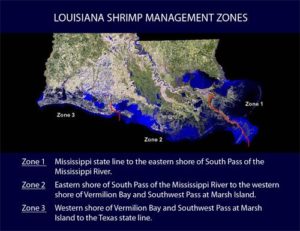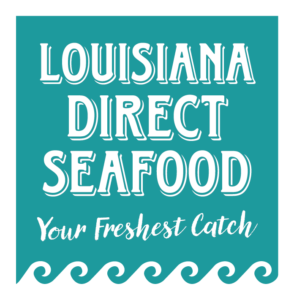Learn more about the main species of seafood that we love to eat here in Louisiana; click on a tab below.
Louisiana is the largest shrimp producing state in the nation. Each year 90 to 120 million pounds of shrimp are landed in the bayou state. Two main species, white shrimp and brown shrimp make up the bulk of the catch. Other shrimp species such as sea bobs, pink shrimp and rock shrimp are also caught but in much smaller quantities. Shrimp are harvested from inshore lakes and bays as well as offshore waters. Brown shrimp are produced in abundance in coastal regions with higher salinity.
The historical spring and fall seasons are managed by LDWF to correspond with shrimp life cycles, abundance and size. Louisiana is split into 3 shrimp management zones.
Shrimp seasons (variable):
- Spring inshore: May to July
- Fall inshore: August to December
- State offshore: (coast to 3 miles offshore) open all year with closures as needed
- Federal offshore: (3-200 miles offshore) open all year
Shrimp product forms:
A variety of shrimp products can be purchased locally, both fresh and fresh frozen. Whole and headless (shell on) fresh shrimp is commonly available from our local shrimp fleet. In addition, peeled and peeled-deveined shrimp are also available from local processing plants.
Fresh shrimp bought direct from commercial fishers can be either whole or headless. Most inshore boats store their catch on ice and come to port daily or every few days. Many of the local larger offshore boats bring in heads-on, individually quick frozen (IQF) frozen shrimp. These IQF shrimp are brine frozen at sea in mesh bags similar to crawfish sacks. Freezing allows for extended time (sometimes weeks) at sea. Well handled frozen shrimp is an excellent product.
Fresh Shrimp: Shrimp should have a mild sea breeze, ocean smell. Shells should hold tightly to the flesh and legs should be intact. Meat should be firm and translucent. Avoid product with any scent of ammonia. Nothing tastes better than fresh shrimp right off the boat.
Frozen Shrimp: Shrimp can be purchased block frozen from processing plants or individually quick frozen (IQF). Shrimp should be frozen solid and properly glazed to prevent dehydration and freezer burn. Many consumers prefer frozen product due to ease of handling and storage. Frozen shrimp in most forms can be purchased by the 5-lb box or by the 50 pound case. IQF shrimp headless or peeled from the processor plants are sold in 5 pound bags or 20 pound cases. Boat frozen IQF shrimp are stored and sold in 70-75 pound bags. Frozen shrimp are available year round and the next best thing to fresh shrimp.
Shrimp sizes (count):
Consumers often find shrimp being sold by sizes such as large, medium and small. These categories can have different meanings and be confusing. For example medium sized shrimp at one place can be a considered large shrimp at another. Shrimp size standards have been developed to help solve this problem. Larger shrimp are usually cost more than small shrimp. Headless shrimp will also cost more than a heads-on shrimp of the same count size.
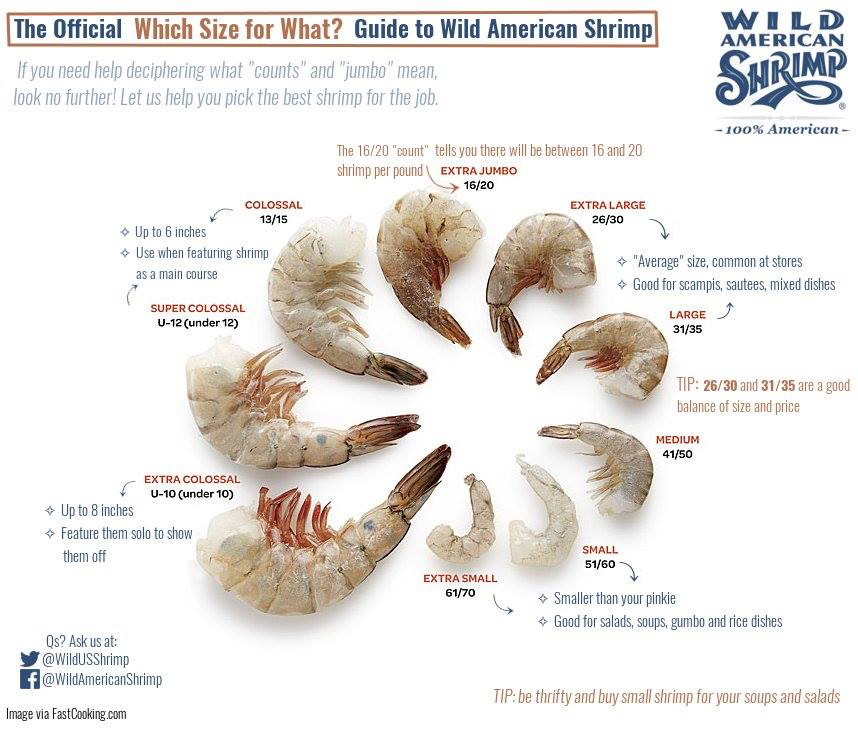
Shrimp count will increase by 2 counts sizes when the head is removed and 1 more count size when the shell is removed. A 16/20 heads-on shrimp become a 26/30 when the head is removed and then a 31/35 when peeled.
Transporting Shrimp:
Be prepared with proper sized containers and adequate ice when transporting shrimp. Most shrimpers will have ice available to keep your purchase cold but check in advance to be certain. Frozen product should not be iced but placed in ice chest or insulated container for transportation. Containers should be shaded from direct sunshine and kept as cool as possible. Make sure you have enough container space for shrimp and ice.

Longer travel time and warmer temps may require more ice. Remember a full ice chest is quite heavy. Use the handy guide at right for transporting shrimp.
How much to buy:
Boiled shrimp: Plan on ½ to 1 pound of shell-on shrimp per person for boiled shrimp. Amount needed depends on whether sides such as corn, potatoes, sausage etc are being served. Also consider appetite level. Shrimp amounts can be scaled up some for the football team party and down a bit for the ladies book club boil.
Shrimp yield: When buying heads-on shrimp remember that removing the heads will decrease total weight by 35%. When the shell is removed weight decreases by another 15%. For example, 100 pounds of heads-on shrimp will result in 65 pounds of heads-off shrimp. When shells are removed 50 pounds of shrimp flesh is the result.
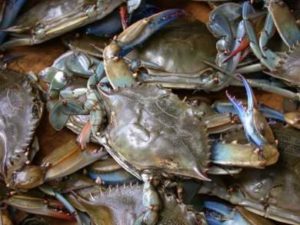
Callinectes sapidus, or ‘beautiful swimmer’.
Louisiana supports the largest crab production of both hard and soft-shell crabs in the nation, and is the number one suppliers of live #1 male crab in the southern states. The blue crab is one of the most popular food species of the more than 4,500 species of crabs found worldwide. The Louisiana blue crab is harvested year round in bayous, rivers, and inlets of Louisiana as well as the near-shore waters of the Gulf of Mexico, with the peak harvest of crabs during the warm water months of summer and fall. Crabs are caught primarily in wire crab traps baited with fish. Licensed commercial fishermen can harvest crab using legally acceptable means throughout the year.
Blue crab availability varies with the season to correspond with the crab’s life cycles, abundance and size. The blue crab population undergoes a series of molts and intermolts stages as they grow and mature. Thus, catches are composed of hard shell crabs, peeler crabs (about to shed), and soft-shell crabs (just shed still soft). Molt cycles are related to moon phases and growing conditions and occur in market-sized crabs about every 30 days.
Crab Availability:
Live hard shell crabs: Year round, most plentiful and meaty during warmer months when feeding activity increases with warmer waters, and more scarce during colder months with March being the month least available Freshwater crabs: Are just saltwater blue crabs that have migrated inland to freshwater rivers and lakes. These are mostly male crabs and can attain a large size under ideal conditions.
Soft-shell crabs: Primarily March through November, most productive during May through September, and scarce when water temperature drops below 50 degrees Fahrenheit
Crab Product Forms & Handling:
A variety of crab products can be purchased locally, jimmies (males) and sooks (females) are available in various market forms and should be handled accordingly. Because jimmies are larger and meatier, they are more desirable when prepared whole-steamed or boiled. Sooks are often sold to commercial processing plants to be picked by hand and packaged as fresh or pasteurized meat. Pasteurization preserves the shelf life of the crab without changing the taste, appearance, and texture.
- Fresh, live, hard shell crabs: Crab should be alive, legs should move, and shell should not be slippery when touched. To ensure freshness, only cook crabs that are alive. Remove any dead crabs prior to cooking. Cooked crabs should smell fresh.
- Frozen, hard shell crabs: Store in freezer at 0 degrees Fahrenheit and use within two months. Thaw in the refrigerator for a day before using.
- Pasteurized crab meat: Storage temperature is crucial when handling pasteurized crab meat. Pasteurized products that are refrigerated at 32-36 degrees F can have a shelf life of up to 6 months without changing the flavor, color and texture of the product. Bulk inventories should be rotated so that the oldest product is used first. For home use, unopened pasteurized crab meat should be used within 60 days of the time it was purchased. Once opened, the product must be kept refrigerated and used within 5 days to ensure freshness.
- Fresh-picked crabmeat is available in the following forms:
- Lump (Jumbo)- the highest quality of solid lumps of white meat, sweetest, best used when appearance is important
- Backfin- consist of both lump and flake body meats, mild flavor, can be used to substitute lump meat
- Flake (special or regular)- small pieces of white body meat
- Claw- brownish in color, meat from the claw, richer flavor, most often used in recipe when appearance is less important i.e. stuffed crabs
- Crab Fingers (Cocktail Claws)- actual pincer of the crab, often used in appetizers/cocktails
- Live soft-shell crabs: Fragile and needs to be handled with extreme care. Soft-shell crabs should be stored in a cool moist environment (48-50 degrees F). Shelf life may be 3-4 days. Frozen soft-shell crabs: Individually wrapped in plastic wrap, white butcher paper, or vacuum packed. For highest quality, soft-shell crabs should be cleaned just before cooking. Avoid purchasing precut soft-shell crab which causes drip loss, thus losing firmness and flavor.
Crab Sizes:
Hard shell crabs: A legal sized hard crab in Louisiana must measure 5 inches shell width (point to point). Larger crabs can usually command higher prices. There are no standard industry grades for hard and soft-shell crabs. Consumers will find crab sizes referred to as large, medium, and small. Sometimes crabs are also graded as number one (male “jimmies”, most meaty), number twos (male “jimmies”, less meaty), and number threes (mix of ungraded, small crabs, often females). Most hard shell crabs are sold by the dozen, bushel or crate. A dozen crabs are exactly 12 crabs. The actual number of crabs in a bushel depends on the size of the crabs. To avoid confusion when ordering hard shell crabs, buyers should specify the size desired (in inches) and use the following table as a guide:
| SIZE NAME | CRAB DIMENSIONS | DOZENS PER BUSHEL | CRABS PER BUSHEL |
| Colossal | 6 ½ or more inches | 4-5 dozen | 48-60 crabs |
| Jumbo | 6 – 6 ½ inches | 5 – 6 dozen | 60 – 72 crabs |
| Large | 5 ½ – 6 inches | 6 – 7 dozen | 72 – 84 crabs |
| Medium | 5 – 5 ½ inches | 7 – 8 dozen | 84 – 96 crabs |
| Small, usually females | 4 ½ – 5 inches | 8-9 dozen | 96 – 84 crabs |
Fat Crabs vs. Empty Crabs: Those crabs that are empty or light in weight have recently molted. A larger new crab shell is produced through the molting process to allow for growth. That same lighter, empty crab will fill with muscle over time and become a full fat crab. This cycle will continue until maturity. Crabs that have just molted are bright, clean and shiny. Full crabs tend to appear darker and more discolored.
Soft-shell crabs: For soft-shell crabs, dozens are generally sold “straight-run,” which includes all sizes, or graded as small, medium, and large. Individual producers may sell by weight or other means. Thus, to avoid confusion when buying soft-shell crabs, buyers should specify by size (in inches) or weight. See sizing and weight chart provided as a guide:
| SIZE NAME | CRAB DIMENSIONS | AVERAGE WEIGHT | DOZENS PER TRAY | DOZENS PER CASE |
| Whales | 5 ½ inches + | 5.9 oz | 2 | 6 |
| Jumbos | 5 – 5 ½ inches | 4.5 oz | 3 | 9 |
| Primes | 4 ½ – 5 inches | 3.3 oz | 4 | 12 |
| Hotels | 4 – 4 ½ inches | 2.5 oz | 5 | 15 |
| Mediums | 3 ½ – 4 inches | 1.8 oz | 6 | 18 |
Transporting and Holding Crabs:
Live crabs should be stored in a suitable container with a layer of ice at the bottom when transporting. Container should be shaded from direct sunshine, lid cracked open to allow for fresh air in, and kept as cool as possible (50 degrees F). Crabs should be stored upright. They must be kept separate from melted ice water to avoid suffocation. Meat quality also becomes “mealy” instead of flaky in crabs that have been submerged for a time in ice water. Live crabs in good condition can be kept alive
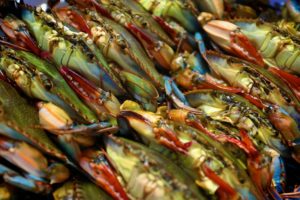
Soft-shell crabs
overnight in an ice chest if kept cool and held above the ice and water. Crabs can also be stored for a few hours in a wooden crab box or hamper with damp burlap cover. Be prepared with container and ice when making large purchase of live crabs. Do not purchase weak or dead crabs. Discard any dead crabs prior to cooking.
For live soft-shell crab, waxed boxes, beer flats or specially designed soft-shell crab boxes can be used to package and transit crabs. Arrange crabs with faces upward to allow air to enter their gill chamber. Cover with wet paper or thin cloth. Do not stack boxes. Remember, to keep the crabs moist and cool but not crush or allow moisture to leak out of the crabs.
How Much to Buy
Crab yield: Remember, when buying blue crab the actual edible portion of meat is quite low. The picked meat yield depends on the size of the crab and the experience of the crab picker. For example, an average matured crab weighs approximately 1/3 pound. An experienced crab picker can produce about 2 ¼ ounces of meat from each pound of live blue crabs. This is about a 14% yield once the shell is removed and all edible meat picked. Therefore, a dozen of live crabs weighing approximately 4 pounds will yield only 1/2 pound of actual edible meat.
Boiled crabs: Plan on 2 to 4 crabs per person depending on size for boiled crabs. Generally, a bushel of #1 will hold 60-72 crabs, which will feed about 10 – 12 people. If other foods are on the menu, then only half as many crabs are needed. Also consider crowd and appetite level.
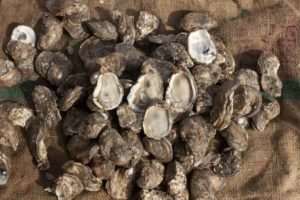 The American or Eastern oyster, or Crassostrea virginica, is found intertidally and subtidally in estuaries (sounds, bays, bayous, tidal creeks) from Brunswick, Canada through the Gulf of Mexico.
The American or Eastern oyster, or Crassostrea virginica, is found intertidally and subtidally in estuaries (sounds, bays, bayous, tidal creeks) from Brunswick, Canada through the Gulf of Mexico.
Biology:
Bivalve mollusk with two asymmetric shells attached at hinge. Shell weight and shape vary greatly depending on age, location and growing conditions. Shell color usually gray-brown. Left shell, attached to substrate, is usually more deeply cupped. Muscle scar purple in color and found inside the shells where adductor muscle attaches.
Oysters are filter feeders and capture phytoplankton, dissolved organic material and other appropriately sized particles from the water column as food. Adults accumulate glycogen reserves (fatten) during the winter months and develop ripe gonads during early-late spring. Rising coastal water temperatures stimulate external spawning of eggs and sperm by adults generally in the late spring/early summer. Planktonic, swimming life stages include trochophore larvae, which develop within the first 24 hrs after fertilization, then into shelled, veliger stages (D-hinge, umbo, late umbo and pediveligers). Tides and currents carry the larvae throughout the estuary for 12-21 days until pediveligers settle and crawl to find suitable hard substrate to attach and undergo metamorphosis into sedentary stage (spatfall). Spat (<1 inch) grow to seed (>1) and adult sizes (>2) with increasing shell size. Adults form vast reef communities providing critical estuarine habitat.
Oysters are euryhaline and can survive in nearly freshwater, but salinities <10ppt inhibit gonadal development. Spatfall increases with increasing salinity, but predation and disease stymie recruitment to seed and adult sizes above 15ppt, depending on location within the estuary
Food Value:
Market size is generally >3 inches, but varies by state and harvest/farming method and market demand. Generally served raw on the half-shell and lightly cooked in many recipes.
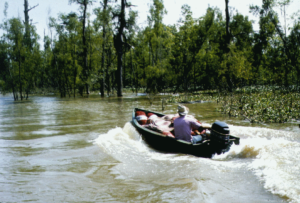
Crawfishing in the Atchafalaya Basin
Long before rice farmers stocked their ponds to produce crawfish, these tasty crustaceans inhabited the Atchafalaya Basin and other natural wetland habitats in Louisiana. They still do. And in the springtime, commercial fishermen work the bayous and backwater swamps to harvest and deliver millions of pounds of crawfish to the market. The life cycle of the wild caught crawfish revolves around the natural wet and dry seasons in the wetlands. Typically during the late summer and fall, the swamps of the Atchafalaya dry up and force the crawfish to burrow into holes where they await the next flood. As the snow melts and spring rains flow south and into the Basin, this annual flooding forces the crawfish from their burrows.
Depending on the timing, crawfish emerge with their babies during the winter and populate the habitat. The cold water slows their growth but usually by April, May and June, the young have grown to market size. If sufficient water fills the Basin earlier, fishermen can get into places and harvest some of the older crawfish a month or two before the young of the year crop is ready.
So the “wild” crawfish season depends on the timing and extent of the annual flooding of the Basin. Water gives the crawfish life and water affords access for the fishermen. Generally, one only needs to look at the water level forecast for the Basin during the evening news to judge the volume of crawfish harvested during the spring.
RED and WHITE CRAWFISH:
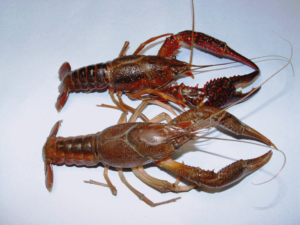
Red swamp crawfish (top) vs white river crawfish (bottom)
To the untrained eye, all crawfish coming out of the boiling pot look alike. Most of them will be the red swamp crawfish that scientist refer to as procambarus clarkii. But a few will be the white river crawfish, technically known as procambarus zonangulus. Most people will never notice as the steam rises from the pile of boiled crawfish on the table surrounded by friends and family.
The white river crawfish have a more elongated claw than the red swamp and will usually be lighter colored, even when boiled. The reds will have a yellow colored “fat” in the head while the whites have a green tinted “fat.” They are both equally delicious.
AVAILABILITY:
Wild caught crawfish are most available in April, May and June depending on water level. A limited supply is sometimes harvested earlier if water levels are sufficient to provide access.
PRICING:
The price of crawfish will vary depending on the supply of crawfish on the market, the demand of crawfish by consumers and the size of the crawfish.
MARKETING:
Fishermen who harvest wild crawfish are licensed commercial fishermen. They can sell their catch directly to the public or to licensed seafood dealers.
HANDLING:
Crawfish are sold as a live product in open mesh sacks. When purchasing a sack of crawfish, handle the sack with care and keep in a shaded, cool place until ready to cook. Crawfish can be kept in a cooler overnight or with crushed ice melting through the sack. Sacks of crawfish can be immersed in water to moisten but only for a few minutes. Sacked crawfish left in water for longer can suffocate.
CLEANING:
Empty the crawfish into a wash tub to rinse away any mud and remove bits of vegetation or bait that may have fallen into the sack. Change the water two or three times but do not soak the crawfish in the water for more than a few minutes as they will suffocate from lack of oxygen.
PURGING:
True purging to empty the digestive track of crawfish takes 12 to 24 hours. Adding salt to the wash water does not purge crawfish.
COOKING:
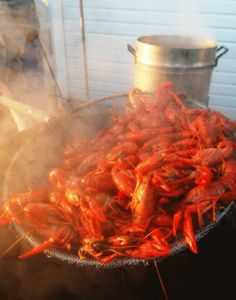
Cook time will vary slightly depending on the size and the shell condition of the crawfish. Fast growing crawfish with greenish, thin shells will cook faster than larger crawfish with heavy dark colored shells. The critical thing is to bring the internal temperature up to 145 degrees. This will take 3 to 5 minutes once the water returns to a boil. Cooking longer will result in hard-to-peel crawfish. Adding salt to the water will also make them harder to peel.
SEASONING:
Seasoning can either be added to the boiling water, added after or both, depending on the “spiciness” desired. Liquid or powdered spices can be added to the boiling water along with other treats like corn, potatoes or even pork sausage. Soaking in the seasoned water lets the spices penetrate. A popular alternative is to place the crawfish in a container and sprinkle with Cajun spices. Cover and let sit for several minutes.
FREEZING:
Boiled crawfish can be frozen whole, as unpeeled tails or as peeled tail meat. It takes 7 to 8 pounds of crawfish to yield one pound of tail meat.
NUTRITION:
Although crawfish tend to be higher in cholesterol than other seafood, a 3 ounce serving has only 116 miligrams or about a third of the daily recommended allowance. That amount of crawfish meat has only 70 calories and just one gram of total fat. Without the seasoning, it has only 160 grams of sodium.
Click here for more nutrition details:
Crawfish fact sheet prepared by Mark Shirley, LSU AgCenter/Sea Grant. mshirley@agctr.lsu.edu
Coming soon.

